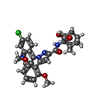[English] 日本語
 Yorodumi
Yorodumi- PDB-6z4s: Crystal structure of the neurotensin receptor 1 (NTSR1-H4bmx) in ... -
+ Open data
Open data
- Basic information
Basic information
| Entry | Database: PDB / ID: 6z4s | ||||||
|---|---|---|---|---|---|---|---|
| Title | Crystal structure of the neurotensin receptor 1 (NTSR1-H4bmx) in complex with the small molecule inverse agonist SR48692 | ||||||
 Components Components | Neurotensin receptor type 1,DARPin,HRV 3C protease recognition sequence | ||||||
 Keywords Keywords |  MEMBRANE PROTEIN / GPCR ligand complex / MEMBRANE PROTEIN / GPCR ligand complex /  NTSR1 / SR48692 / NTSR1 / SR48692 /  inverse agonist inverse agonist | ||||||
| Function / homology |  Function and homology information Function and homology informationPeptide ligand-binding receptors / G protein-coupled neurotensin receptor activity / inositol phosphate catabolic process / positive regulation of inhibitory postsynaptic potential / symmetric synapse / D-aspartate import across plasma membrane / positive regulation of gamma-aminobutyric acid secretion / L-glutamate import across plasma membrane / positive regulation of arachidonic acid secretion / neuron spine ...Peptide ligand-binding receptors / G protein-coupled neurotensin receptor activity / inositol phosphate catabolic process / positive regulation of inhibitory postsynaptic potential / symmetric synapse / D-aspartate import across plasma membrane / positive regulation of gamma-aminobutyric acid secretion / L-glutamate import across plasma membrane / positive regulation of arachidonic acid secretion / neuron spine / regulation of respiratory gaseous exchange / negative regulation of release of sequestered calcium ion into cytosol / negative regulation of systemic arterial blood pressure / G alpha (q) signalling events / positive regulation of glutamate secretion / positive regulation of inositol phosphate biosynthetic process /  temperature homeostasis / response to lipid / temperature homeostasis / response to lipid /  regulation of membrane depolarization / detection of temperature stimulus involved in sensory perception of pain / neuropeptide signaling pathway / axon terminus / adult locomotory behavior / positive regulation of release of sequestered calcium ion into cytosol / dendritic shaft / regulation of membrane depolarization / detection of temperature stimulus involved in sensory perception of pain / neuropeptide signaling pathway / axon terminus / adult locomotory behavior / positive regulation of release of sequestered calcium ion into cytosol / dendritic shaft /  learning / learning /  terminal bouton / cytoplasmic side of plasma membrane / terminal bouton / cytoplasmic side of plasma membrane /  perikaryon / perikaryon /  dendritic spine / positive regulation of apoptotic process / dendritic spine / positive regulation of apoptotic process /  membrane raft / membrane raft /  axon / neuronal cell body / axon / neuronal cell body /  dendrite / protein-containing complex binding / positive regulation of gene expression / negative regulation of apoptotic process / dendrite / protein-containing complex binding / positive regulation of gene expression / negative regulation of apoptotic process /  cell surface / identical protein binding / cell surface / identical protein binding /  plasma membrane plasma membraneSimilarity search - Function | ||||||
| Biological species |   Rattus norvegicus (Norway rat) Rattus norvegicus (Norway rat)synthetic construct (others) | ||||||
| Method |  X-RAY DIFFRACTION / X-RAY DIFFRACTION /  SYNCHROTRON / SYNCHROTRON /  MOLECULAR REPLACEMENT / Resolution: 2.707 Å MOLECULAR REPLACEMENT / Resolution: 2.707 Å | ||||||
 Authors Authors | Deluigi, M. / Klipp, A. / Hilge, M. / Merklinger, L. / Klenk, C. / Plueckthun, A. | ||||||
| Funding support |  Switzerland, 1items Switzerland, 1items
| ||||||
 Citation Citation |  Journal: Sci Adv / Year: 2021 Journal: Sci Adv / Year: 2021Title: Complexes of the neurotensin receptor 1 with small-molecule ligands reveal structural determinants of full, partial, and inverse agonism. Authors: Deluigi, M. / Klipp, A. / Klenk, C. / Merklinger, L. / Eberle, S.A. / Morstein, L. / Heine, P. / Mittl, P.R.E. / Ernst, P. / Kamenecka, T.M. / He, Y. / Vacca, S. / Egloff, P. / Honegger, A. / Pluckthun, A. | ||||||
| History |
|
- Structure visualization
Structure visualization
| Structure viewer | Molecule:  Molmil Molmil Jmol/JSmol Jmol/JSmol |
|---|
- Downloads & links
Downloads & links
- Download
Download
| PDBx/mmCIF format |  6z4s.cif.gz 6z4s.cif.gz | 174.9 KB | Display |  PDBx/mmCIF format PDBx/mmCIF format |
|---|---|---|---|---|
| PDB format |  pdb6z4s.ent.gz pdb6z4s.ent.gz | Display |  PDB format PDB format | |
| PDBx/mmJSON format |  6z4s.json.gz 6z4s.json.gz | Tree view |  PDBx/mmJSON format PDBx/mmJSON format | |
| Others |  Other downloads Other downloads |
-Validation report
| Arichive directory |  https://data.pdbj.org/pub/pdb/validation_reports/z4/6z4s https://data.pdbj.org/pub/pdb/validation_reports/z4/6z4s ftp://data.pdbj.org/pub/pdb/validation_reports/z4/6z4s ftp://data.pdbj.org/pub/pdb/validation_reports/z4/6z4s | HTTPS FTP |
|---|
-Related structure data
| Related structure data |  6yvrSC 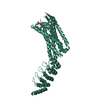 6z4qC  6z4vC 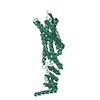 6z66C 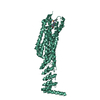 6z8nC  6za8C  6zinC S: Starting model for refinement C: citing same article ( |
|---|---|
| Similar structure data |
- Links
Links
- Assembly
Assembly
| Deposited unit | 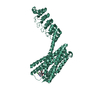
| ||||||||
|---|---|---|---|---|---|---|---|---|---|
| 1 |
| ||||||||
| Unit cell |
|
- Components
Components
| #1: Protein | Mass: 53153.266 Da / Num. of mol.: 1 Mutation: S83G,A86L,T101R,H103D,H105Y,L119F,M121L,R143K,A161V,R167L,R213L,V234L,K235R,V240L,I253A,I260A,N262R,K263R,H305R,C332V,F342A,T354S Source method: isolated from a genetically manipulated source Details: Residues 60-371 represent the rat neurotensin receptor 1 mutant H4bm (NTSR1-H4bm). Residues 273 to 290 were deleted for crystallisation purposes. Residues 372 to 380 form a linker connecting ...Details: Residues 60-371 represent the rat neurotensin receptor 1 mutant H4bm (NTSR1-H4bm). Residues 273 to 290 were deleted for crystallisation purposes. Residues 372 to 380 form a linker connecting NTSR1 with the DARPin crystallisation chaperone. Residues 381 to 536 represent the DARPin crystallisation chaperone that is related to 5LW2. Residues 537 to 539 represent a short linker connecting the DARPin crystallisation chaperone with the HRV 3C protease recognition sequence. Residues 540 to 545 are part of the HRV 3C protease recognition sequence visible in the electron density.,Residues 60-371 represent the rat neurotensin receptor 1 mutant H4bm (NTSR1-H4bm). Residues 273 to 290 were deleted for crystallisation purposes. Residues 372 to 380 form a linker connecting NTSR1 with the DARPin crystallisation chaperone. Residues 381 to 536 represent the DARPin crystallisation chaperone that is related to 5LW2. Residues 537 to 539 represent a short linker connecting the DARPin crystallisation chaperone with the HRV 3C protease recognition sequence. Residues 540 to 545 are part of the HRV 3C protease recognition sequence visible in the electron density.,Residues 60-371 represent the rat neurotensin receptor 1 mutant H4bm (NTSR1-H4bm). Residues 273 to 290 were deleted for crystallisation purposes. Residues 372 to 380 form a linker connecting NTSR1 with the DARPin crystallisation chaperone. Residues 381 to 536 represent the DARPin crystallisation chaperone that is related to 5LW2. Residues 537 to 539 represent a short linker connecting the DARPin crystallisation chaperone with the HRV 3C protease recognition sequence. Residues 540 to 545 are part of the HRV 3C protease recognition sequence visible in the electron density. Source: (gene. exp.)   Rattus norvegicus (Norway rat), (gene. exp.) synthetic construct (others) Rattus norvegicus (Norway rat), (gene. exp.) synthetic construct (others)Gene: Ntsr1, Ntsr / Production host:   Escherichia coli (E. coli) / References: UniProt: P20789 Escherichia coli (E. coli) / References: UniProt: P20789 |
|---|---|
| #2: Chemical | ChemComp-Q6Q / |
| Has ligand of interest | Y |
-Experimental details
-Experiment
| Experiment | Method:  X-RAY DIFFRACTION / Number of used crystals: 1 X-RAY DIFFRACTION / Number of used crystals: 1 |
|---|
- Sample preparation
Sample preparation
| Crystal | Density Matthews: 2.43 Å3/Da / Density % sol: 49.44 % |
|---|---|
Crystal grow | Temperature: 293.15 K / Method: lipidic cubic phase Details: 100 mM Na citrate 225-460 mM ammonium nitrate 30-32% (v/v) PEG400 1 uM SR48692 PH range: 4.8-51 |
-Data collection
| Diffraction | Mean temperature: 100 K / Serial crystal experiment: Y |
|---|---|
| Diffraction source | Source:  SYNCHROTRON / Site: SYNCHROTRON / Site:  SLS SLS  / Beamline: X06SA / Wavelength: 1.000009 Å / Beamline: X06SA / Wavelength: 1.000009 Å |
| Detector | Type: DECTRIS EIGER X 16M / Detector: PIXEL / Date: Dec 8, 2019 |
| Radiation | Protocol: SINGLE WAVELENGTH / Monochromatic (M) / Laue (L): M / Scattering type: x-ray |
| Radiation wavelength | Wavelength : 1.000009 Å / Relative weight: 1 : 1.000009 Å / Relative weight: 1 |
| Reflection | Resolution: 2.707→29.353 Å / Num. obs: 10475 / % possible obs: 90.6 % / Redundancy: 7.3 % / CC1/2: 0.964 / Rmerge(I) obs: 0.525 / Rpim(I) all: 0.198 / Rrim(I) all: 0.564 / Net I/σ(I): 4.3 |
| Reflection shell | Resolution: 2.707→3.029 Å / Rmerge(I) obs: 4.678 / Mean I/σ(I) obs: 1.4 / Num. unique obs: 524 / CC1/2: 0.294 / Rpim(I) all: 1.504 / Rrim(I) all: 4.929 |
| Serial crystallography sample delivery | Method: fixed target |
- Processing
Processing
| Software |
| |||||||||||||||||||||||||||||||||||||||||||||||||||||||||||||||||||||||||||||||||||||||||||||||||||||||||||||||||||||||||||||||||||||||||||||||||||||||||||
|---|---|---|---|---|---|---|---|---|---|---|---|---|---|---|---|---|---|---|---|---|---|---|---|---|---|---|---|---|---|---|---|---|---|---|---|---|---|---|---|---|---|---|---|---|---|---|---|---|---|---|---|---|---|---|---|---|---|---|---|---|---|---|---|---|---|---|---|---|---|---|---|---|---|---|---|---|---|---|---|---|---|---|---|---|---|---|---|---|---|---|---|---|---|---|---|---|---|---|---|---|---|---|---|---|---|---|---|---|---|---|---|---|---|---|---|---|---|---|---|---|---|---|---|---|---|---|---|---|---|---|---|---|---|---|---|---|---|---|---|---|---|---|---|---|---|---|---|---|---|---|---|---|---|---|---|---|
| Refinement | Method to determine structure : :  MOLECULAR REPLACEMENT MOLECULAR REPLACEMENTStarting model: 6YVR Resolution: 2.707→29.353 Å / Cor.coef. Fo:Fc: 0.873 / Cor.coef. Fo:Fc free: 0.848 / WRfactor Rfree: 0.285 / WRfactor Rwork: 0.269 / SU B: 21.592 / SU ML: 0.412 / Average fsc free: 0.8505 / Average fsc work: 0.8675 / Cross valid method: FREE R-VALUE / ESU R Free: 0.523 Details: Hydrogens have been added in their riding positions
| |||||||||||||||||||||||||||||||||||||||||||||||||||||||||||||||||||||||||||||||||||||||||||||||||||||||||||||||||||||||||||||||||||||||||||||||||||||||||||
| Solvent computation | Ion probe radii: 0.7 Å / Shrinkage radii: 0.7 Å / VDW probe radii: 1.1 Å / Solvent model: MASK BULK SOLVENT | |||||||||||||||||||||||||||||||||||||||||||||||||||||||||||||||||||||||||||||||||||||||||||||||||||||||||||||||||||||||||||||||||||||||||||||||||||||||||||
| Displacement parameters | Biso mean: 38.575 Å2
| |||||||||||||||||||||||||||||||||||||||||||||||||||||||||||||||||||||||||||||||||||||||||||||||||||||||||||||||||||||||||||||||||||||||||||||||||||||||||||
| Refinement step | Cycle: LAST / Resolution: 2.707→29.353 Å
| |||||||||||||||||||||||||||||||||||||||||||||||||||||||||||||||||||||||||||||||||||||||||||||||||||||||||||||||||||||||||||||||||||||||||||||||||||||||||||
| Refine LS restraints |
| |||||||||||||||||||||||||||||||||||||||||||||||||||||||||||||||||||||||||||||||||||||||||||||||||||||||||||||||||||||||||||||||||||||||||||||||||||||||||||
| LS refinement shell |
|
 Movie
Movie Controller
Controller



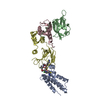

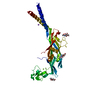
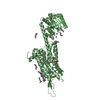
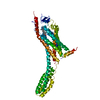

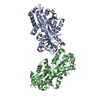

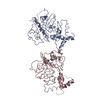
 PDBj
PDBj







